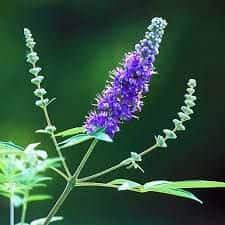


Common Name
Chasteberry,
Monk’s Pepper,
Vitex,
Abraham’s balm
Family
Lamiaceae (formerly Verbenaceae)
Parts Used
Fruits and seeds
Native To
Native to the Mediterranean region, Central Asia, and parts of Africa, commonly found in temperate and tropical climates.
Historical and Traditional Uses:
- Ancient Greece and Rome: Used for hormonal balance and to promote chastity, hence the name “monk’s pepper.”
- Medieval Europe: Utilized for menstrual irregularities and as a general tonic for women’s health.
- Ayurveda and Traditional Medicine: Applied for its anti-inflammatory and analgesic properties.
Chemical Composition:
- Flavonoids: Apigenin, casticin, luteolin
- Diterpenes: Rotundifuran, agnuside
- Iridoid Glycosides: Aucubin, agnuside
- Essential Oils: 1,8-cineole, limonene
- Other Compounds: Alkaloids, fatty acids, and tannins
Pharmacological Properties:
- Dopaminergic Effects: Modulates prolactin secretion via dopamine receptor activation.
- Hormonal Modulation: Influences pituitary activity, promoting progesterone production.
- Anti-inflammatory: Reduces inflammatory mediators.
- Antioxidant Activity: Neutralizes oxidative stress.
Evidence-Based Uses and Benefits:
1. Premenstrual Syndrome (PMS):
- Evidence: Reduces symptoms such as mood swings, irritability, and breast tenderness.
- Key Study: Schellenberg, 2001 demonstrated efficacy in PMS symptom relief (DOI: 10.1016/S0378-5122(01)00221-3)
2. Menstrual Irregularities:
- Mechanism: Balances luteinizing hormone (LH) and follicle-stimulating hormone (FSH).
3. Hyperprolactinemia:
- Effect: Reduces prolactin levels, alleviating symptoms such as infertility and luteal phase defects.
4. Acne Management:
- Evidence: May reduce androgen-driven acne due to hormonal modulation.
5. Menopausal Symptom Relief:
- Use: Alleviates mild symptoms like hot flashes and mood changes.
Counter-Indications:
- Pregnancy and breastfeeding (may influence hormonal levels).
- Hormone-sensitive conditions such as breast, uterine, or ovarian cancers.
- Conditions involving dopamine dysregulation (e.g., Parkinson’s disease).
Side Effects:
- Mild gastrointestinal upset.
- Headache or dizziness.
- Skin reactions (rash, itching) in sensitive individuals.
- Potential menstrual cycle changes during initial use.
Drug Interactions:
- Dopamine Agonists/Antagonists: May enhance or counteract effects.
- Hormonal Therapies: Potential interaction with oral contraceptives or hormone replacement therapies.
- Herbs: Use cautiously with other hormone-modulating herbs (e.g., black cohosh, red clover).
Research and White Papers with Links:
- Psychic aspects of the premenstrual dysphoric disorders. New therapeutic strategies: our experience with Vitex agnus castus.
- The premenstrual syndrome: effectiveness of Vitex agnus castus.
- Treatment of cyclical mastodynia using an extract of Vitex agnus castus: results of a double-blind comparison with a placebo.
- Vitex agnus castus extract in the treatment of luteal phase defects due to latent hyperprolactinemia. Results of a randomized placebo-controlled double-blind study.
- Chaste tree (Vitex agnus-castus)–pharmacology and clinical indications.
Conclusion:
Chasteberry (Vitex agnus-castus) is a well-researched herbal remedy that has been used for centuries to support women's health, particularly in relation to hormonal balance. Its therapeutic potential lies in its dopaminergic and hormone-modulating effects, which have been shown to alleviate symptoms of PMS, menstrual irregularities, and mild menopausal symptoms. With a long history of traditional use and ongoing modern research to support its efficacy, chasteberry remains a cornerstone in herbal medicine for women's hormonal health. However, caution is advised when using chasteberry, particularly in hormone-sensitive conditions or when combined with medications affecting dopamine or hormonal pathways. As with any herbal remedy, it is essential to consult with a healthcare professional before using chasteberry, especially if you have any underlying medical conditions or take medications.



